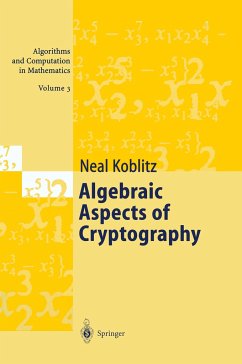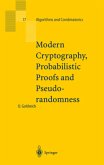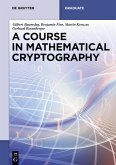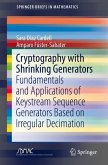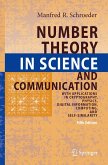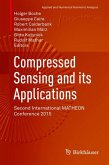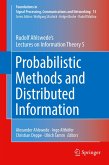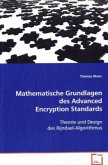From the reviews: "This is a textbook in cryptography with emphasis on algebraic methods. It is supported by many exercises (with answers) making it appropriate for a course in mathematics or computer science. [...] Overall, this is an excellent expository text, and will be very useful to both the student and researcher." Mathematical Reviews
This book is intended as a text for a course on cryptography with emphasis on algebraic methods. It is written so as to be accessible to graduate or advanced undergraduate students, as well as to scientists in other fields. The first three chapters form a self-contained introduction to basic concepts and techniques. Here my approach is intuitive and informal. For example, the treatment of computational complexity in Chapter 2, while lacking formalistic rigor, emphasizes the aspects of the subject that are most important in cryptography. Chapters 4-6 and the Appendix contain material that for the most part has not previously appeared in textbook form. A novel feature is the inclusion of three types of cryptography - "hidden monomial" systems, combinatorial-algebraic sys tems, and hyperelliptic systems - that are at an early stage of development. It is too soon to know which, if any, of these cryptosystems will ultimately be of practical use. But in the rapidly growing field of cryptography it is worthwhile to continually explore new one-way constructions coming from different areas of mathematics. Perhaps some of the readers will contribute to the research that still needs to be done. This book is designed not as a comprehensive reference work, but rather as a selective textbook. The many exercises (with answers at the back of the book) make it suitable for use in a math or computer science course or in a program of independent study.
This book is intended as a text for a course on cryptography with emphasis on algebraic methods. It is written so as to be accessible to graduate or advanced undergraduate students, as well as to scientists in other fields. The first three chapters form a self-contained introduction to basic concepts and techniques. Here my approach is intuitive and informal. For example, the treatment of computational complexity in Chapter 2, while lacking formalistic rigor, emphasizes the aspects of the subject that are most important in cryptography. Chapters 4-6 and the Appendix contain material that for the most part has not previously appeared in textbook form. A novel feature is the inclusion of three types of cryptography - "hidden monomial" systems, combinatorial-algebraic sys tems, and hyperelliptic systems - that are at an early stage of development. It is too soon to know which, if any, of these cryptosystems will ultimately be of practical use. But in the rapidly growing field of cryptography it is worthwhile to continually explore new one-way constructions coming from different areas of mathematics. Perhaps some of the readers will contribute to the research that still needs to be done. This book is designed not as a comprehensive reference work, but rather as a selective textbook. The many exercises (with answers at the back of the book) make it suitable for use in a math or computer science course or in a program of independent study.
From the reviews: "... This is a textbook in cryptography with emphasis on algebraic methods. It is supported by many exercises (with answers) making it appropriate for a course in mathematics or computer science. ... Overall, this is an excellent expository text, and will be very useful to both the student and researcher." (M.V.D.Burmester, Mathematical Rezensions 2002).
"... This is a textbook in cryptography with emphasis on algebraic methods. It is supported by many exercises (with answers) making it appropriate for a course in mathematics or computer science. ... Overall, this is an excellent expository text, and will be very useful to both the student and researcher."
M.V.D.Burmester, Mathematical Reviews 2002
"... I think this book is a very inspiring book on cryptography. It goes beyond the traditional topics (most of the cryptosystems presented here are first time in a textbook, some of Paturi's work is not published yet). This way the reader has the feeling how easy to suggest a cryptosystem, how easy to break a safe looking system and hence how hard to trust one. The interested readers are forced to think together with ther researchers and feel the joy of discovering new ideas. At the same time the importance of "hardcore" mathematics is emphasized and hopefully some application driven students will be motivated to study theory."
Péter Hajnal, Acta Scientiarum Mathematicarum, 64.1998, p. 750
"... Overall, the book is highly recommended to everyone who has the requisite mathematical sophistication."
E.Leiss, Computing Reviews 1998, p. 506
"... Der Autor, der ... vielen Lesern dieses Rundbriefs gut bekannt sein wird, hat hier ein kleines Werk vorgelegt, das man wohl am Besten als "Lesebuch zu algebraischen Aspekten der Kryptographie mit öffentlichem Schlüssel" charakterisieren kann. ...
Mit zunehmender Schwierigkeit des Material werden die Ausführungen dabei skizzenhafter und beschränken sich immer stärker auf den Hinweis auf entsprechende Quellen, was den Charakter eines guten "Lesebuchs", wie ich es oben bezeichnet habe, ausmachen sollte. Das Buch eignet sich damit selbst für "advanced undergraduates", wie es im Klappentext heißt, als Einstieg und erster Überblick über ein Gebiet, in dem sich in den letzten Jahren auf überraschendeWeise praktische Anwendungsmöglichkeiten für tief innermathematische Themen ergeben haben."
Hans-Gert Gräbe, Computeralgebra Rundbrief 1999, Issue 25
"... Es gelingt Koblitz, anschaulich und mit elementaren Mitteln auch Dinge zu erläutern, die in vergleichbaren Texten kaum zu finden sind: z.B. den Hilbertschen Basis- und Nullstellensatz, sowie Gröbnerbasen. ..."
Franz Lemmermeyer, Mathematische Semesterberichte 1999, 46/1
M.V.D.Burmester, Mathematical Reviews 2002
"... I think this book is a very inspiring book on cryptography. It goes beyond the traditional topics (most of the cryptosystems presented here are first time in a textbook, some of Paturi's work is not published yet). This way the reader has the feeling how easy to suggest a cryptosystem, how easy to break a safe looking system and hence how hard to trust one. The interested readers are forced to think together with ther researchers and feel the joy of discovering new ideas. At the same time the importance of "hardcore" mathematics is emphasized and hopefully some application driven students will be motivated to study theory."
Péter Hajnal, Acta Scientiarum Mathematicarum, 64.1998, p. 750
"... Overall, the book is highly recommended to everyone who has the requisite mathematical sophistication."
E.Leiss, Computing Reviews 1998, p. 506
"... Der Autor, der ... vielen Lesern dieses Rundbriefs gut bekannt sein wird, hat hier ein kleines Werk vorgelegt, das man wohl am Besten als "Lesebuch zu algebraischen Aspekten der Kryptographie mit öffentlichem Schlüssel" charakterisieren kann. ...
Mit zunehmender Schwierigkeit des Material werden die Ausführungen dabei skizzenhafter und beschränken sich immer stärker auf den Hinweis auf entsprechende Quellen, was den Charakter eines guten "Lesebuchs", wie ich es oben bezeichnet habe, ausmachen sollte. Das Buch eignet sich damit selbst für "advanced undergraduates", wie es im Klappentext heißt, als Einstieg und erster Überblick über ein Gebiet, in dem sich in den letzten Jahren auf überraschendeWeise praktische Anwendungsmöglichkeiten für tief innermathematische Themen ergeben haben."
Hans-Gert Gräbe, Computeralgebra Rundbrief 1999, Issue 25
"... Es gelingt Koblitz, anschaulich und mit elementaren Mitteln auch Dinge zu erläutern, die in vergleichbaren Texten kaum zu finden sind: z.B. den Hilbertschen Basis- und Nullstellensatz, sowie Gröbnerbasen. ..."
Franz Lemmermeyer, Mathematische Semesterberichte 1999, 46/1
"... Der Autor, der ... vielen Lesern dieses Rundbriefs gut bekannt sein wird, hat hier ein kleines Werk vorgelegt, das man wohl am Besten als "Lesebuch zu algebraischen Aspekten der Kryptographie mit öffentlichem Schlüssel" charakterisieren kann. ... Mit zunehmender Schwierigkeit des Material werden die Ausführungen dabei skizzenhafter und beschränken sich immer stärker auf den Hinweis auf entsprechende Quellen, was den Charakter eines guten "Lesebuchs", wie ich es oben bezeichnet habe, ausmachen sollte. Das Buch eignet sich damit selbst für "advanced undergraduates", wie es im Klappentext heißt, als Einstieg und erster Überblick über ein Gebiet, in dem sich in den letzten Jahren auf überraschende Weise praktische Anwendungsmöglichkeiten für tief innermathematische Themen ergeben haben." Hans-Gert Gräbe, Computeralgebra Rundbrief 1999, Issue 25

